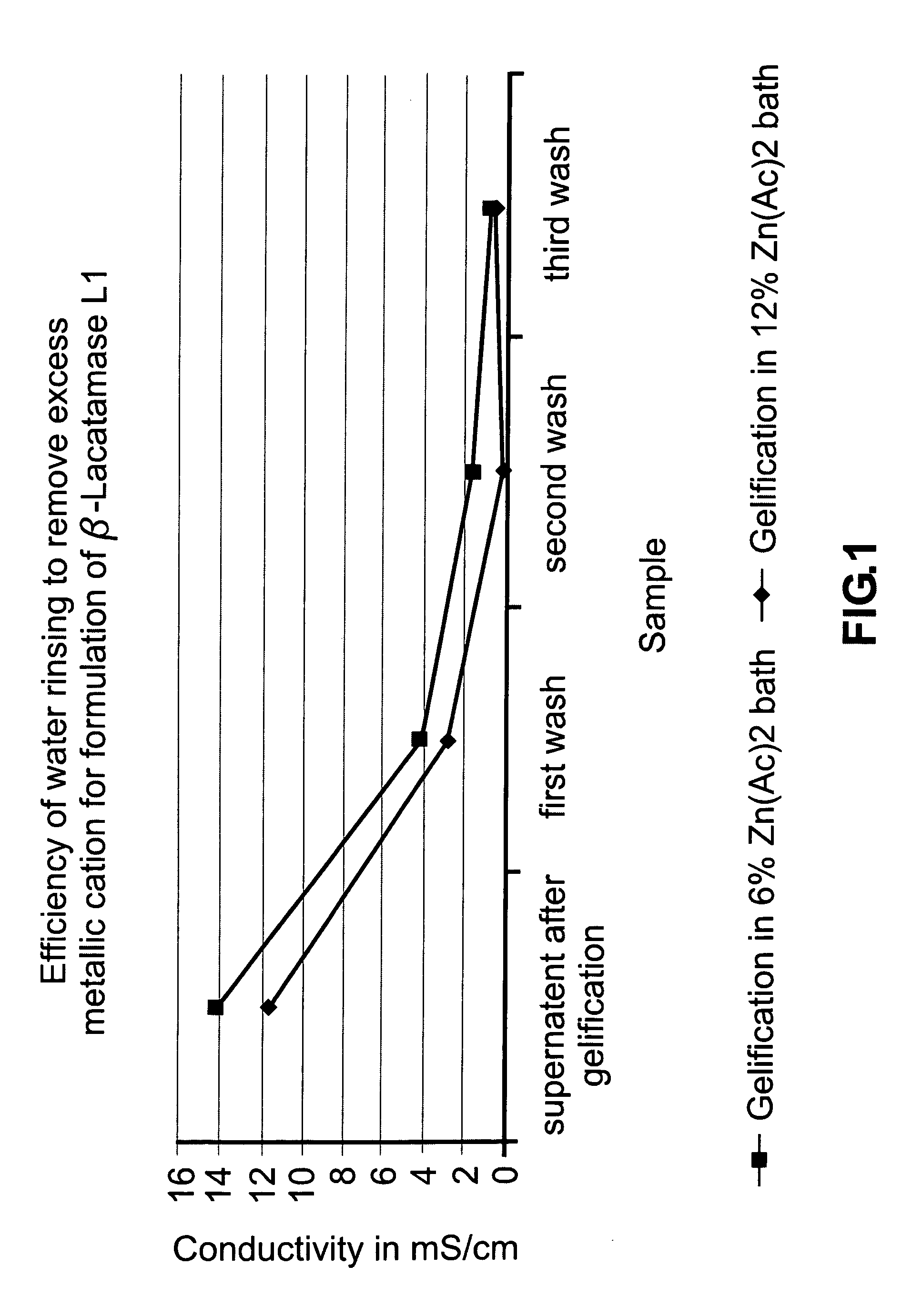Colonic delivery of metallo-dependent enzymes
- Summary
- Abstract
- Description
- Claims
- Application Information
AI Technical Summary
Benefits of technology
Problems solved by technology
Method used
Image
Examples
example 1
Development of a Sensitive, Quantitative and Specific Assay for β-lactamase L1
[0097]Hydrolysis of nitrocefin is a well known technique used to quantify penicillinase activity. However, the usual format is in single tubes and is not adapted for analysis of a large number of samples. This example describes the development and fit for purpose qualification of this assay in 96 wells microplate format
[0098]Stock solution of Nitrocefin was obtained by solubilization of the Nitrocefin dried powder at a concentration of 10 mM in dimethylsulfoxide (DMSO). The stock solution was stored at −20° C. and diluted 100-fold immediately prior to use in 50 mM sodium phosphate buffer (Hepes buffer) pH 7.0 containing 0.1 mg / ml bovine serum albumin (BSA). Buffer selection is described in table I.
[0099]20 μl containing the solution to be analyzed were added to 180 μl of diluted Nitrocefin. Kinetics of Nitrocefin hydrolysis are followed at 37° C. with a measure of absorbance at 492 nm each 30 seconds usin...
example 2
Instability of β-lactamase L1 In Original Pectin Mix and Effect of Metallic Counter-Ion
[0104]0.3 ml of β-lactamase L1 (Eurogentec, Belgium, approx. 10 mg / mL as determined by μBCA assay) was mixed to 10 g of a 6% pectin solution (Low methoxylated amidated pectin (Unipectine), Texturant Systems, cat# OG175C) made in water; the pH of the pectin solution was not adjusted.
[0105]The pectin / β-lactamase L1 mixture was added drop-wise over a period of 2 minutes using a peristaltic pump and a needle of 0.8 mm inner diameter to a beaker containing 40 ml of calcium chloride (6%) under agitation (200 rpm) at room temperature.
[0106]After further incubation to allow equilibration between free and bound calcium ions, beads were recovered by filtration and washed 3 times in 200 ml of purified water to eliminate excess of free calcium. At this stage, beads are referred to as “gelled beads”.
[0107]Beads were dried 2 hours at 37° C. in an oven, yielding dried beads.
[0108]2×5 droplets and 2×15 droplets w...
example 3
Optimization of Metallic Ion Used to Gel the Pectin, and the Effect of pH of the Pectin Solution.
[0111]In order to decipher the effects of the pectin solution parameters and Zinc ions, an experiment comparing four formulations was performed (design was build according to factorial design, Design Expert 6.0.10, Stat-Ease, Mineapollis). Two parameters were tested:
[0112](a) pH of the pectin solution: 4.0 and 7.0
[0113](b) metallic cation in the gelification bath: Ca2+ (CaCl2) or Zn2+ (Zinc acetate abbreviated ZnAc)
[0114]Beads were prepared as described in Example 2. However, the concentration of the pectin solution was decreased from 6% to 4% due to the decrease in solubility of pectin with increased pH. The encapsulation yield was measured by assaying the enzymatic activity of β-Lactamase L1 as described in Example 1.
[0115]5 beads were solubilized in 20 ml of 10 mM Hepes, 145 mM NaCl, 0.1 mg / ml BSA pH 7.4 in the presence or absence 1% pectinase (Pectinases from Aspergillus Aculeatus, P...
PUM
| Property | Measurement | Unit |
|---|---|---|
| Volume | aaaaa | aaaaa |
| Volume | aaaaa | aaaaa |
| Volume | aaaaa | aaaaa |
Abstract
Description
Claims
Application Information
 Login to View More
Login to View More - R&D
- Intellectual Property
- Life Sciences
- Materials
- Tech Scout
- Unparalleled Data Quality
- Higher Quality Content
- 60% Fewer Hallucinations
Browse by: Latest US Patents, China's latest patents, Technical Efficacy Thesaurus, Application Domain, Technology Topic, Popular Technical Reports.
© 2025 PatSnap. All rights reserved.Legal|Privacy policy|Modern Slavery Act Transparency Statement|Sitemap|About US| Contact US: help@patsnap.com



